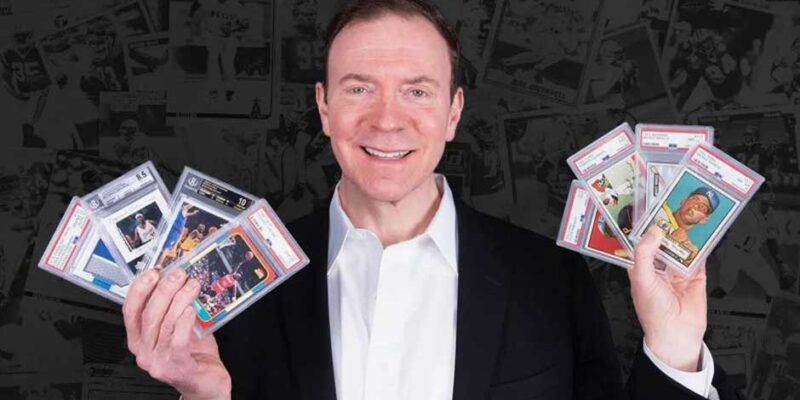Ever wonder how someone turns a childhood hobby into hundreds of millions of dollars? Meet Ken Goldin, the guy who did exactly that with baseball cards.
Most kids collect cards for fun. Ken Goldin? He saw dollar signs. Fast-forward four decades, and this 59-year-old from Philadelphia has built a collectibles empire that’s made him one of the richest people in sports memorabilia.
Ken Goldin’s net worth tells a story that’s part nostalgia, part business genius, and entirely American dream. From swapping cards as a teenager to starring in his own Netflix show, Goldin has turned what many consider a “niche hobby” into serious money.
Ken Goldin Net Worth: The Real Numbers
So, what’s Ken Goldin worth in 2025? The answer depends on who you ask.
Most recent estimates put Ken Goldin’s net worth at around $350 million. But here’s the thing – different sources give wildly different numbers, ranging anywhere from $50 million to $350 million.
Why such a huge spread? Simple. Goldin’s wealth is tied up in a business that deals with one-of-a-kind items. Try putting a price tag on a 1952 Mickey Mantle rookie card or Michael Jordan’s game-worn jersey. It’s not like valuing Apple stock.
What we do know for sure: Goldin Auctions, the company he started in 2012, is absolutely crushing it. The business model is pretty straightforward – Goldin takes about 20% of every sale. When your company moves $300 million worth of collectibles in a single year (like they did in 2022), that 20% adds up fast.
Here’s some quick math: $300 million in sales × 20% commission = $60 million in revenue. Not bad for a year’s work.
The guy has facilitated over $1.3 billion in memorabilia sales throughout his career. That’s billion with a “B.” No wonder they call him the “King of Collectibles.”
From Baseball Cards to Business Empire: Ken Goldin’s Origin Story
Ken Goldin wasn’t born rich. He grew up in Cherry Hill, New Jersey, just another kid obsessed with the Philadelphia Phillies. Like millions of other kids, he collected baseball cards.
The difference? At 13, Goldin started selling them.
Most teenagers in 1978 were worried about homework and weekend plans. Goldin was already thinking like an entrepreneur. He had this natural ability to spot which cards would go up in value and which ones were just cardboard waiting to happen.
By the time he hit college, his card-trading profits were covering his entire education. Think about that for a second – a teenager was making enough money from baseball cards to pay for college. That’s when you know someone’s got serious business instincts.
His parents, Paul and Carole Goldin, could have pushed him toward a “real job.” Instead, they saw what their son was building and supported his unconventional path. Sometimes the best thing parents can do is get out of the way.
Building The Score Board: Ken Goldin’s First Big Win
Fresh out of Drexel University in 1986, Goldin teamed up with his dad to create The Score Board Inc. This wasn’t your typical father-son business venture.
The Score Board had a killer idea: exclusive autograph deals with professional athletes. While other companies were fighting over the same generic merchandise, Goldin was locking up the stars themselves.
The timing was perfect. Sports memorabilia was starting to heat up, and The Score Board positioned itself right at the center of the action. They went public in 1987 and hit $1 million in sales their first year.
By 1989, they were doing $20 million annually. Not bad for a company that started in someone’s basement.
But here’s where Goldin showed his real business smarts: he knew when to leave. In 1997, sensing trouble ahead, he walked away from The Score Board. Good thing, too – the company filed for bankruptcy shortly after.
That move taught Goldin a valuable lesson about timing and market cycles. It’s a lesson that would serve him well in his next venture.
The Goldin Auctions Revolution: Changing the Game
After leaving The Score Board, Goldin spent over a decade working with TV shopping networks like QVC and HSN. Sounds boring, right? Wrong.
Those years taught him everything about mass market psychology and consumer behavior. He learned how to present items on camera, how to create urgency, and most importantly, how to tell stories that make people want to buy.
In 2012, Goldin decided it was time to go big again. He founded Goldin Auctions with a simple mission: become the go-to place for high-end sports collectibles.
The company started small – just $800,000 in sales the first year. But Goldin had bigger plans.
The growth has been absolutely insane. From $101 million in sales in 2020 to $300 million in 2022. That’s nearly triple growth in just two years.
In May 2024, eBay bought Goldin Auctions. The exact purchase price wasn’t disclosed, but considering the company’s growth trajectory, it was definitely a big payday for Goldin. He’s still running the show as founder and CEO, which means he gets the best of both worlds – eBay’s resources with his expertise.
Record-Breaking Sales: When Ken Goldin Makes Headlines
Want to understand why Ken Goldin’s net worth keeps climbing? Look at some of his biggest sales.
The crown jewel: a 1952 Mickey Mantle rookie card that sold for over $12 million. Twelve. Million. Dollars. For a piece of cardboard.
But that’s not even the whole story. Goldin also sold a Mike Trout rookie card for $3.93 million. This one was huge because Trout is still playing – it proved that modern cards could command crazy money too.
Then there’s the Michael Jordan jersey that went for $1.3 million. Game-worn Jordan gear is basically sports memorabilia gold, and Goldin knows how to market it better than anyone.
These aren’t just random sales. Each one represents Goldin’s ability to authenticate items, tell their stories, and create bidding frenzies that drive prices through the roof.
The guy doesn’t just sell collectibles – he sells dreams, memories, and pieces of sports history. That’s why people pay premium prices.
Netflix Fame: How “King of Collectibles” Changed Everything
In April 2023, Ken Goldin became a Netflix star. “King of Collectibles: The Goldin Touch” gave viewers an inside look at his auction house and the wild world of high-end collectibles.
The show was a massive hit. It peaked at #4 in the US and #20 worldwide. Netflix even renewed it for a second season, which dropped in June 2024.
But this wasn’t just about fame – it was about business. The Netflix exposure introduced Goldin to millions of potential new customers. Suddenly, people who had never thought about collecting sports memorabilia were watching him sell cards for millions of dollars.
The show also legitimized the entire collectibles market. When Netflix makes a documentary about your industry, it’s officially mainstream.
For Goldin personally, the show has been a game-changer. He’s gone from being known in collector circles to being a household name. That kind of brand recognition is worth millions in marketing value.
Ken Goldin’s Money Machine: How the Business Really Works
Understanding Ken Goldin’s wealth means understanding how his business actually makes money. It’s simpler than you might think.
The core model: commission-based sales. Goldin takes roughly 20% of every successful auction. The higher the final price, the more money he makes. This creates perfect alignment between Goldin and his consigners – everyone wins when prices go up.
But that’s not the only revenue stream. Private sales are huge, especially for the most valuable items. Some collectors prefer to buy and sell discreetly, and Goldin facilitates these deals for substantial fees.
Authentication services are another money-maker. Goldin’s reputation means his stamp of approval can add serious value to an item. Collectors pay premium fees for his authentication because they know it makes their items more valuable and easier to sell.
Don’t forget about media appearances and speaking engagements. Since the Netflix show, Goldin has become a sought-after speaker and media personality. These gigs pay well and serve as marketing for his core business.
The beauty of this model is that it scales. As the collectibles market grows, Goldin’s revenue grows with it. He’s not just riding the wave – he’s helping create it.
Beyond the Auction House: Ken Goldin’s Personal Side
Despite his public profile, Ken Goldin keeps his personal life relatively private. He’s married to Jennifer, and they have three kids: Laura, Paul, and Carleigh.
Family clearly matters to Goldin. He’s often talked about how his father’s early support was crucial to his success. Now he’s in a position to provide the same kind of support to his own children.
Goldin’s wealth has opened doors for philanthropy. He chairs the Camcare Charitable Foundation and works with organizations like Pat & Emmitt Smith Charities. He also serves on the Board of Directors for the Philadelphia Museum of Sports, combining his business expertise with his passion for sports history.
Unlike some wealthy entrepreneurs who flaunt their success, Goldin seems more focused on growing his business and giving back. His approach to wealth reflects the same long-term thinking that built his empire – sustainable growth over flashy spending.
What’s Next for Ken Goldin’s Fortune?
Looking ahead, Ken Goldin’s financial future looks incredibly bright. The eBay acquisition opens up possibilities that could multiply his wealth significantly.
eBay brings global reach and technological resources that could help Goldin expand internationally. The collectibles market is exploding in Asia and other emerging regions – imagine Goldin Auctions tapping into those markets with eBay’s infrastructure.
The collectibles market itself shows no signs of slowing down. Younger generations are treating alternative assets like sports cards and gaming memorabilia as serious investments. This demographic shift suggests sustained demand for years to come.
New technologies like blockchain authentication and digital collectibles present additional opportunities. Goldin’s brand and expertise position him perfectly to capitalize on these trends while maintaining his dominance in traditional collectibles.
Industry experts predict the global collectibles market could hit $1 trillion by 2030. If Goldin maintains his current market position, his personal wealth could grow well beyond current estimates.
The Bottom Line on Ken Goldin’s Net Worth
Ken Goldin’s journey from a 13-year-old selling baseball cards to building a $350 million fortune is the kind of success story that only happens in America. His wealth isn’t built on abstract financial instruments or tech algorithms – it’s rooted in physical objects that carry real emotional and historical significance.
What makes Goldin’s story so compelling is its authenticity. This is a guy who genuinely loves what he does and has turned that passion into extraordinary wealth. He’s bridged the gap between nostalgia and investment in a way that benefits everyone involved.
For anyone thinking about turning their hobby into a business, Goldin’s story offers some clear lessons: deep expertise matters, timing is everything, and sometimes the most unconventional paths lead to the biggest rewards.
As the collectibles market continues to evolve, Ken Goldin’s position as the “King of Collectibles” looks secure. His combination of industry knowledge, business acumen, and media savvy has created competitive advantages that will be tough for anyone to replicate.
Ken Goldin’s net worth of $350 million proves that with the right mix of passion, expertise, and business sense, even childhood hobbies can become the foundation for generational wealth. Not bad for a kid who just loved baseball cards.















